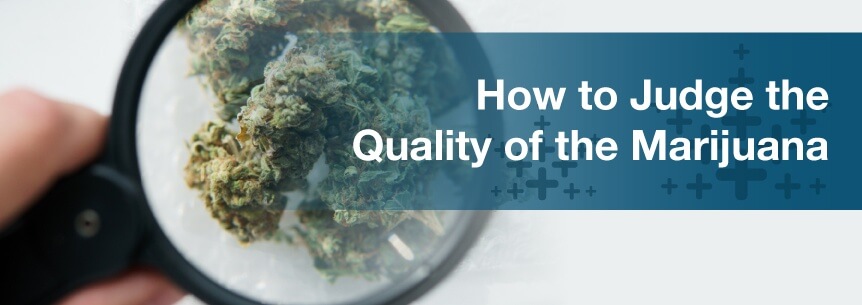
Access to quality cannabis remains one of the premiere concerns within the industry — both for doctors, patients and those exploring the ever-evolving applications behind one of the world’s oldest whole-plant medicines.
While medical cannabis has undeniable health benefits, patients can’t tap into those benefits unless they’re utilizing the highest possible quality of marijuana.
Beyond the desire for product safety and reliability, knowing how to judge the quality of cannabis allows for more empowered consumer decision-making. By recognizing the characteristics to look for when judging marijuana and understanding the difference between high-quality and subpar cannabis, you can be sure your body gets the best.
People turn to medical marijuana for a variety of health-based, personal and lifestyle reasons. Regardless of the rationale, every consumer deserves transparent, health-supporting strains grown by professionals who take their role within the industry seriously.
It is essential to be knowledgeable and proactive about the quality of cannabis for three key reasons.
Following the larger logic behind most things we consume and metabolize, the fresher it is, the more “goodies” our bodies can extract from it.
Like produce straight from farmer’s market, high-quality cannabis contains a more elaborate mix of the 400 to 500 chemical compounds known to exist within its composition. More than 60 of those compounds are cannabinoids with an impressive array of medical purposes.
If you’re routinely opting for inexpensive or lower-quality kush, you’re missing out on the abundant blend of antioxidants, flavonoids and phytonutrients present in certified, professionally grown and high-quality buds.
The lower the quality of weed, the lower the complexity of cannabinoid concentrations. With a lower level of cannabinoids, you will be less likely to experience balanced, more-regulated interactions within your endocannabinoid system.
Conversely, poor-quality or inexpensive strands can hold higher levels of cannabidiol (CBD), a nonpsychoactive chemical compound that is harvested for its medicinal properties and does not have the euphoric or mood-enhancing attributes of tetrahydrocannabinol (THC).
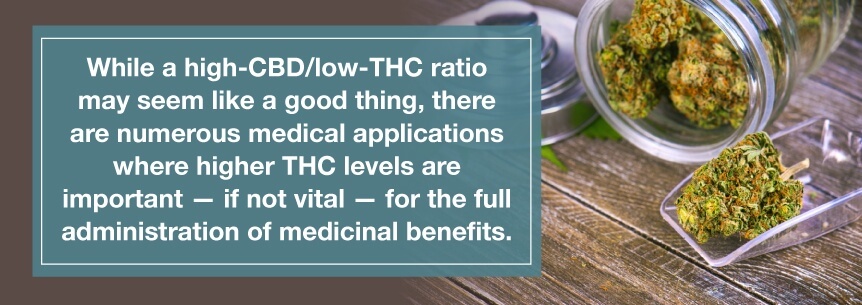
While a high-CBD/low-THC ratio may seem like a good thing, there are numerous medical applications where higher THC levels are important — if not vital — for the full administration of medicinal benefits. Less potency due to poor-quality weed might minimize these health advantages, particularly for pain-reducing applications.
Low-quality cannabis strains carry a higher risk for taints and defects. These corruptions stem from three main factors:
As a result, the condition of the buds deteriorates at a much faster rate than their freshly sealed or professionally harvested cousins. This results in noticeably dryer, lighter and thinner buds in muddier brown shades rather than the vibrant greens, oranges and other desired color schemes.
Low-quality cannabis defects commonly include:
Individuals looking for the highest-quality, most health-supporting marijuana need the right information to assess their choices and make a confident purchase. In areas where access to fresh, premium and medically backed strains are more difficult due to geographic or legal parameters, this information is all the more vital.
Use the following six factors as a guide for making safer, more informed judgment calls on the quality of marijuana.
It’s hard to mistake the smell of cannabis. However, once you’ve caught whiffs or grown accustomed to the notes of premium-level, top-shelf marijuana, it’s hard to be drawn back to lesser grades.
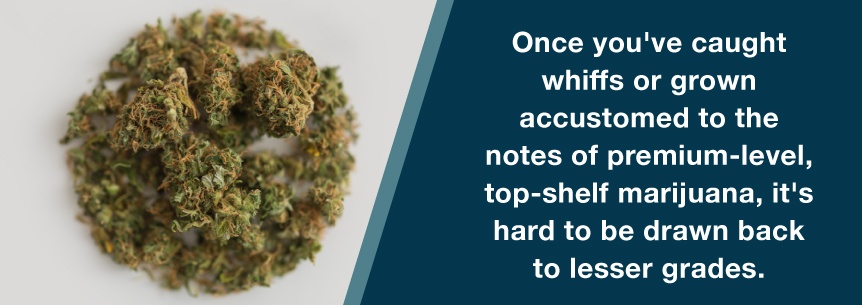
Use your nose as the first detective indicator of the quality of your kush. There’s a reason cannabis smells are so potent, after all — those tiny, crystalline trichomes that dot their exteriors are resin glands that produce what’s known as terpenoids. Nearly 200 different variations exist in these terpenoid secretions, the combination of which is directly responsible for the smell and flavor profiles of strain types. It’s a pungent yet powerful plant fingerprint unique to a cannabis plant.
But don’t be mistaken — not all smells are made equal:
Quality marijuana can genuinely dazzle the user with its shapes and structures. Well-trimmed buds are known for their geometric intactness, showcasing visibly round and symmetrically shaped buds that indicate balanced, even growth.
Pronounced Trichomes
Quality affects both the trichome amount and composition. Craft cannabis from top-tier dispensaries often contains visible, pearly white trichome structures dotting the entirety of a bud.
Trichomes are often nicknamed “sugar” because of the appearance of its look. The more “sugar” you can see on your buds, the better.
Experts compare top-shelf cannabis to the shape of a pinecone when at its peak. This is a simple, effective way to visually assess a critical aspect of marijuana quality — with a few geometric indications.
Individual buds should be relatively even-sized and spaced. While curing marijuana produces variations in a bud’s final appearance, they should still be thick and full in appearance. Clumps of buds together should look lush and even slightly geometric. Your buds should not turn to powder when crushed, but instead, maintain some chunks. Well-cultivated cannabis may also make snapping noises when you grind it down.
The trimming of your marijuana has a lot to tell you about its quality. That’s because higher-level strains tend to be more meticulously trimmed, often by hand.
Growers use specialty scissors and other tools to cut along strategic points in the plant’s nodes, maintaining the integrity of a cola, or group of buds. Stigmas and bracts should be noticeable to the eye, even after packaging compaction. Seeds and stems should be rare, but don’t be surprised if you occasionally find one even in premium cannabis.
Most importantly, the buds themselves should still look plump and round. Crushed, flattened or brittle-appearing buds are a tell-tale sign they’re not nearly as fresh as they could be.
“Hair” might seem like a funny thing to look out for when assessing the quality of marijuana. However, the anatomy of a cannabis plant does, indeed, contain an array of hair-like structures that play an essential role in governing individual bud quality.
That’s because as cannabis plants mature, those wispy, hair-like curls that run throughout the entire cannabis flower grow progressively darker and darker. These curls are known as pistils, and colorful pistils are a key sign of bud freshness.
You’ll be able to tell a plant’s age based on the following hair patterns:
Coloration is the next characteristic to look at when assessing cannabis quality. From the individual buds themselves to the color of residue or remaining oils post-ingestion, you can learn a lot about a strain — including how and where it was grown — from its overall color scheme.
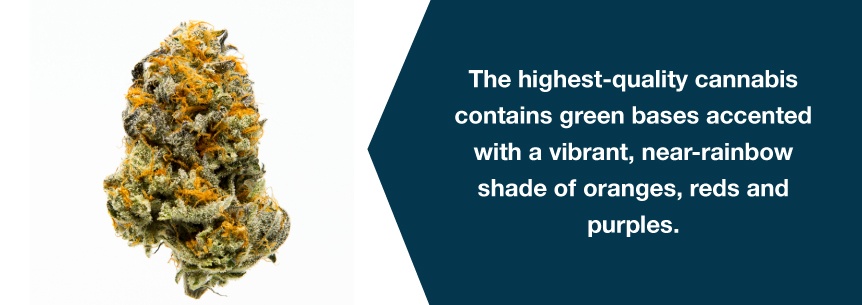
While the vast number of popular marijuana strains come in shades of green, this isn’t the sole color cannabis connoisseurs value. You’ll want to examine the following components:
While senses like smell and sight are more immediate and easily learned forms of assessment, recognizing proper marijuana moisture levels allows you to appraise the age, curing process, storage needs and more factors of quality buds. It sets you up to be an even more informed and conscientious consumer.
If possible, assess the two primary moisture variables in most cannabis flowers:
Touch is an often-neglected variable when it comes to understanding and judging cannabis strains.
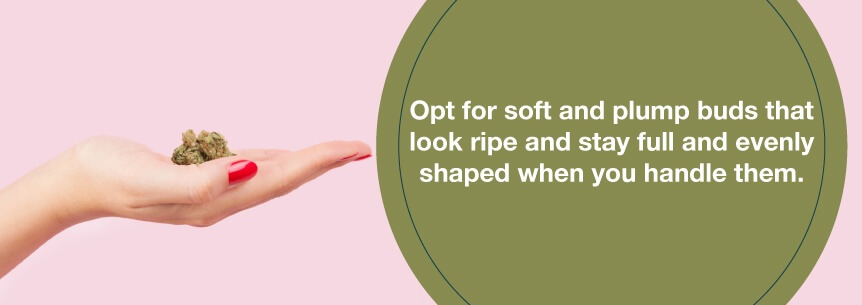
While many budtenders and dispensaries won’t let you touch cuts or buds with your bare hands, they may have tools to evaluate the texture-based aspects of prospective blends. This can easily complement your other forms of assessment to assure quality control with your desired marijuana type:
Low-quality or expired marijuana not only lessons its medicinal properties, but it can also cause adverse side effects or even aggravate some of the conditions patients were attempting to alleviate.
The most common risks to look out for with ingesting low-quality marijuana include:
Don’t hesitate to shop around between multiple dispensaries to guarantee you’re getting the highest quality product for your purchase. Ask budtenders questions about a specific strain’s cultivation, harvesting and curing practices, as well as what would work best for your lifestyle or intended medicinal needs. If you aren’t satisfied with the thoroughness of their answers, look up other area dispensaries to seek their expertise.
MarijuanaDoctors.com is the nation’s premier medical service organization dedicated to connecting patients with cannabis-inclusive medical practitioners and transparent healthcare information. Whether you’re just beginning to research medical marijuana or are looking to update your prescription, MarijuanaDoctors.com can facilitate your needs in this established field of healthcare.
Search our database to find a doctor or a registered dispensary in your area. Or, subscribe to our free newsletter for trusted industry news, information, medical reports and more.
No Information on MarijuanaDoctors.Com should be used to diagnose, treat, prevent or cure any disease or condition. You can view our Full Disclaimer here.